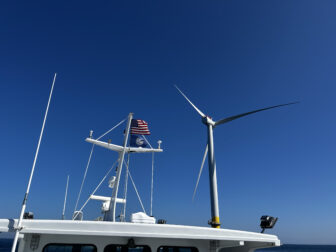
Using every tool available, CCAN and many others have been fighting the massive Cove Point liquefied natural gas (LNG) export terminal for over three years. The facility, located on the Chesapeake Bay in southern Maryland, would be the first LNG export terminal on the East Coast, linking the fracking fields of Pennsylvania, West Virginia, and Ohio to Asian markets. The fight on the ground continues, but our legal fight against the facility reached a significant milestone yesterday. That’s when Earthjustice Managing Attorney Deborah Goldberg faced off with the Federal Energy Regulatory Commission (FERC) and its friends before the DC Circuit Court of Appeals.
Several CCAN staffers and I joined Leslie Garcia and Cindy Peil with Calvert Citizens for a Healthy Community in the gallery to watch the argument.
You may remember that Earthjustice filed the lawsuit, EarthReports v. FERC (No. 15-1127), in May 2015 on behalf of CCAN, Patuxent Riverkeeper, and the Sierra Club. We had to wait to file suit in federal court until FERC officially denied our request for a rehearing. It took the agency seven months to deny our request, even as it approved order after order allowing Dominion to begin construction.
Deborah had eight short minutes to present her argument. Her goal was to show the court that FERC shirked its duty under the National Environmental Policy Act (NEPA) by failing to fully assess the direct and indirect environmental impacts of exporting nearly a billion cubic feet of gas every day for 20 years. Essentially, she argued, FERC’s finding of “no significant impacts” was based on not looking very hard. (You can hear the entire oral argument here.)
She first argued that FERC failed its duty under NEPA when it found that the export facility would not promote any regional gas development. That this massive facility would induce gas development not only makes logical sense, but it’s also backed up by facts. She reminded the court that a Pennsylvania-based energy company plans to drill new wells and ship the gas to Cove Point for export to Japan. She stressed to the court that this new gas production would require the use of millions of gallons of water, thousands of truck trips, and would greatly impact the lives of people living near the not-yet-drilled wells.
She also argued that FERC fell far short of its statutory obligations by refusing to take the lifecycle climate emissions of the project into account. Even the direct emissions of two million tons of greenhouse gases per year, she argued, should have triggered a finding of significance. When you take the lifecycle of natural gas into account, the emissions increase to 26 million tons per year—about the same emissions as Maryland’s entire fleet of coal-fired power plants.
In a strange twist, the energy giant BP was on our side of the aisle yesterday. Before Dominion proposed to expand and convert the terminal, Cove Point was a mostly dormant import facility. Energy companies, including BP and Statoil, had contracts to import natural gas to the terminal. Dominion granted Statoil the opportunity to relinquish its import capacity, but did not grant BP the same opportunity. BP was challenging FERC’s approval of this arrangement.
The attorney for BP walked the judges through the Natural Gas Act and explained why BP should have gotten the same opportunity as Statoil to get out of its contract. The issue was complex, though narrow, and seemed to capture the attention of all the judges on the panel.
Once the petitioners–EarthReports and BP–had finished arguing, it was the respondents’ turn to respond. FERC was joined by Dominion and the American Petroleum Institute, both of which had intervened on FERC’s behalf.
FERC’s attorney was most prepared to discuss the environmental issues but the judges focused the majority of their attention on BP’s claim. While that focus meant that FERC did not have much opportunity to respond to our environmental claims, it also seemed to distract the judges from the larger and more impactful issues at stake. Allowing BP to terminate its contract early has far less of an impact than forcing FERC to fully account for the human and environmental costs of the unprecedented natural gas expansion it’s facilitating.
When FERC’s attorney was able to respond to our environmental claims, she argued that any indirect effects were too speculative for FERC to consider.
Dominion argued that FERC conducted a sufficiently thorough review of the relevant information. Judge Rogers pushed back. Sure, she said, an agency could write 215 pages, but if it left out the main analysis it wasn’t worth much. Summing up our argument, the judge said that these natural gas infrastructure projects have impacts beyond the facility itself that aren’t being considered. “It’s not as if we’re planting flowers here.”
The lawyer from API had nothing new to add.
Deborah had saved two minutes for rebuttal and did an excellent job. Every party was in agreement, she said, on the key question: What effects will this project cause? She argued that Dominion’s liquefaction plant is the “crucial link” inducing demand for more gas drilling. FERC had produced an environmental assessment that turned “a blind eye” to the evidence before it.
She pushed back against FERC’s claim that we were asking the agency to speculate. Federal agencies, from the Environmental Protection Agency to the Council on Environmental Quality, are pushing FERC to consider indirect effects, other agencies are actually doing it, and FERC itself, in subsequent reviews, has even done it. She concluded by asking the DC Circuit to send the order back to FERC for it to conduct a full Environmental Impact Statement.
Every brief we submitted in this case has emphasized FERC’s failure to adequately address the safety threats to nearby residents in Lusby, Maryland. The liquefaction plant in Lusby would be built in closer proximity to residences than any other facility previously approved by FERC. Additionally, our briefs stressed how foreign tanker ships could threaten the critically endangered North Atlantic Right Whale.
This case is one of several where environment groups are challenging FERC approval of natural gas export infrastructure. In November, the DC Circuit heard challenges by Sierra Club and Galveston Baykeeper to FERC’s approval of LNG export facilities at Sabine Pass, Louisiana and Freeport, Texas. Sierra Club has also challenged FERC’s approval of the Corpus Christi, Texas, LNG export facility. That case is fully briefed, but has not yet been set for oral argument.
The court has no deadline to decide our challenge. It’s possible that it’s waiting to hear all the cases against the export facilities before deciding.






